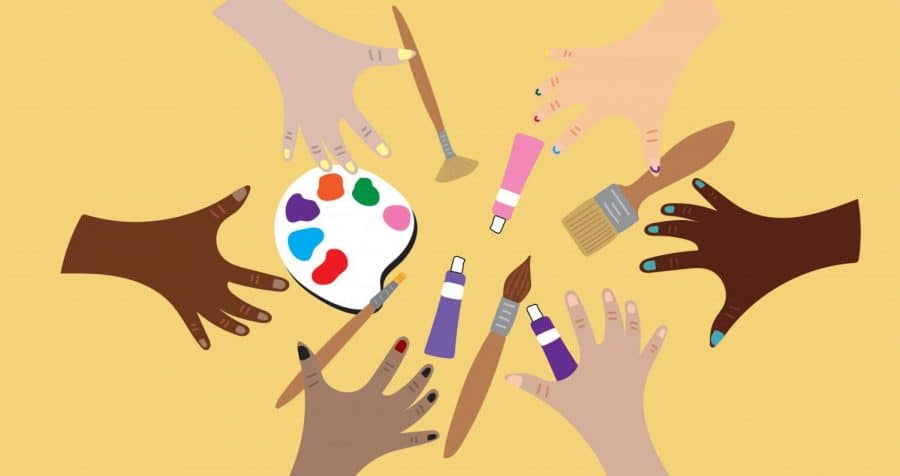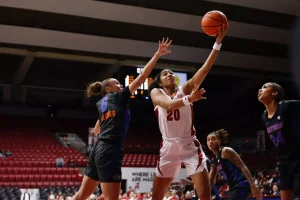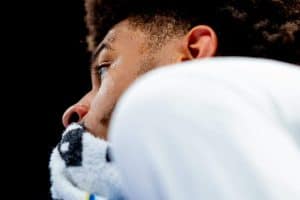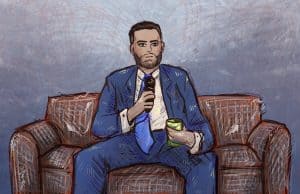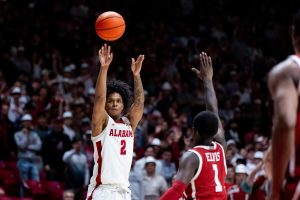New UA organization wants to change campus with art
September 29, 2020
In Woods Quad, there is a sleeping robot. It lies nestled among bushes and shrubs, made of iron and steel, an art piece named “Goldie 1971”. There are several sculptures in the quad, like the basket-like aluminum worm hole “Quilted Vessel” and the ring tangle of “Mobius and Borromean Rings.”
Woods Quad is a rare space at the University that has art displayed in a public space, fittingly, in front of buildings housing the art department. It is a friendly and pleasant space – different than anywhere else on campus. A new organization has formed to create more public spaces like the Woods Quad and promote public art.
This new organization, Art Forward, wants to bring more art to campus and create more inclusivity by widening access to art. The members also want to share the tools of art for all people, particularly people of color who have historically been shut out from the art world, left out of curricula and had less financial wealth. Art Forward wishes to challenge the status quo.
Founder and president Ivy Borden, a sophomore majoring in art history and southern society and culture through New College, explained how she was partly inspired by the summer of protests.
“I got inspired by the idea of it being an art organization,” Borden said.
Borden has always been surrounded by artists, created art and been a part of the art world. Borden and her team members – Sophia Ancira, Xavier Williams, Talya Whyte and Olivia Bennes – want to bring more opportunities to people who have historically been barred from entering the art community or what’s considered “prestigious,” such as museums, training and art societies reserved for a wealthy and often white audience.
She also wants to challenge the “inaccessibility that’s in the art world,” by curbing exclusivity that’s oftentimes associated with an elitist art community.
“Art has a unique ability to show humanity and to inspire empathy for humanity in those who view it,” she said. “… I thought it would be an incredible tool for the fight for social justice.”
To meet that challenge, Art Forward has several goals. They want to analyze and determine if reformation is needed in art history classes and curricula. They also want to have more representation of diverse artists in classes, not just the traditionally white European men considered “Grand Masters,” as Borden called them, who are normally the subjects of art courses.
“In many societies throughout history, art has been an activity that has been restricted to just white men because women or people of color were considered not complex enough… or capable of producing art,” Borden said.
The group wants to create more public art on campus that features murals centered around social justice.
“These murals could possibly be dedicated to Black people’s contributions to campus or UA’s history on civil rights, feminism, and Native American history,” Borden said, “A mural could maybe tell those stories.”
Borden thinks that telling these stories could also improve the environment at the University.
“And in doing so, also provide a more vibrant, artistic campus which I think, in my opinion, alone creates an environment that is more productive and creatively inclined and that’s something I would like to see on UA’s campus,” Borden said.
There have been other student-driven organizations that have pushed for openness and inclusivity, Rachel Dobson, communications specialist for the Art and Art History Department, said. Dobson mentioned the surrealist group called The Raudelunas of the 1970s. The Rainbow of the Arts Festival in 1985, led by then grad student Kathy Bailey, and more recent organizations such as Creative Campus and Creative Coop also advocated for these goals.
The Paul R. Jones Museum is another example of inclusive art that’s tied to campus. The Paul R. Jones Museum displays typically student-curated art from the collection of Alabama-born Paul R. Jones, who collected African American Art throughout his life and donated more than 2000 pieces to the University in 2008. The museum is downtown, accessible to the public throughout the day, and is often used for educational purposes.
Daniel White, the museum’s director, thinks that keeping the museum downtown makes it more accessible by taking away the often-parking difficulty of campus. Wherever art is displayed or shown can create strong opinions, especially on campus and when dealing with social justice and civil rights topics. Many patrons of art may want the political aspect out of their art, unlike the type of art Art Forward hopes to promote, or the type of art the Paul R. Jones Museum showcases regularly.
White said that art is always political.
“There is no separation [between art and politics] like there is with separation of church and state,” White said. “At the heart of who we are at the Paul R. Jones Museum, we support issues involving social justice and we do that through our exhibitions and the artists we work with.”
Art Forward hopes to push into political conversations and have more artists be involved in those. Other long-term goals include a Kentuck-like art fair on campus, where students could create and sell their art. They want to establish an art supply closet, or store, where students could borrow supplies and materials that would be for free or could be purchased with Bama Cash for aspiring artists. Art Forward also plans to advocate for social rights organizations where art events could help supplement missions towards a more inclusive community.
Talya White Sr., Art Forward’s DEI Officer and an artist, works as an acrylic painter. Most of her works are portraits, but she also does abstract pieces and poetry. White wished the organization had been around earlier in her student career.
“I wish [Art Forward] was around my freshman year,” White said. “I think it’s a wonderful use of time, and has the potential to do a lot of good in the community. And it’s well aligned with my passions.”
White thinks art is a powerful mode of self expression and hopes this group can take away the fear of making bad art.
“Sometimes someone doesn’t know they’re an artist until you put a brush in their hand,” White said.
Getting brushes into students’ hands has been difficult this year. Like the entire campus community, the pandemic has put operations on hold and severely altered campus life. The group can not obtain funds from the SOURCE and they can not host in-person gatherings. The general overwhelming nature and virtual fatigue of an altered campus also makes the everyday lives of students all the more difficult. The leadership of Art Forward hopes to create online events, and like many student organization leaders, the team hopes that restrictions will be lifted next year.
If you are interested in art or want to learn more about Art Forward, Ivy Borden encourages people to message the organization through Instagram.
For now, Tuscaloosa locals have places like Woods Quad, the Paul R. Jones Museum, the virtual rooms and galleries on Instagram profiles. And students’ notebooks are blank and waiting.
Editor’s Note: This story was updated on Oct. 2 to correct a name and reflect that the galleries are not empty.



